M0DEG Logbook
I hold the ham radio callsign M0DEG. I've lived at a bunch of QTH's that are not very HF-friendly over the years, so most of my operating is is DXpeditions, SOTA activations or at the pretty amazing shack of my radio club, CUWS (G6UW & M4A).
May 2, 2012 - SOTA Chasers
I'm loving SOTA chasers today. Just come back from an activation of Ben More, GM/SI-003 with my 40m CW rig. The first time I took it out I was worried that no-one would come back to me, and that my CW wouldn't be good enough to actually work anyone.
Three times this week I've called CQ on 7.030+/-, and every time someone has come back to me and patiently accepted my ropey morse code.
While I love walking up mountains, you guys who keep the radio on in the shack and work SOTA activators deserve a shout.
Thank you.
April 24, 2012 - Overengineering
Why bother using a choc-block on the end of a piece of RG-58 when you can have something this overengineered:

March 8, 2012 - Mental Computation of dB
Lets say you want to quickly figure out how many dB there are between 60w and 100w. One way is to approximate this as difference from 50w to 100w, and everyone knows that 2x is 3db. Normally I'd use a calculator if I wanted more precision, but here is a technique that gives about 2 significant figures using a simple table that can be memorised:
| n | 10*log10(n) |
|---|---|
| 2 | 3.0 |
| 3 | 4.8 |
| 5 | 7.0 |
| 7 | 8.5 |
| 11 | 10.4 |
| 13 | 11.1 |
| 17 | 12.3 |
This evaluates 10 * log10(x) of the first few prime numbers. The technique is to find the prime factorisation of the number in question (or a number close to it), look up the log values for the prime factors and add them together.
We are making use of the fact that log(AB) = log(A) + log(B)
Let's consider the question of the ratio of 60w to 100w.
100 is 20dB. We know that.
60 = 10 * 3 * 2. We know that 10x is 10dB, and from the table 2x is 3.0dB and 3x is 4.8dB.
x60 is thus 10 + 3.0 + 4.8 = 17.8dB
The difference between 100 and 60 is thus 20 - 17.8 = 2.2 dB, which is pretty close to the actual value of 2.2184.
For large prime numbers such as 71, pick a number that is close and has a sane factorisation such as 70 = 10 * 7. We know that x10 is 10dB, and the table tells us that x7 is 8.5 db. 10 + 8.5 = 18.5dB, (the actual value is 18.5125).
Easy. Now just learn the table.
February 22, 2012 - Homebrew Noise Bridge
I just spent a few enjoyable evenings building a noise bridge. After my fawning over Small Wonder Labs kits, you'll be glad to know that I built this one from scratch Manhattan style.
I didn't notice it at the time, but guess who was the designer of the New England QRP noise bridge? Yep Dave, K1SWL again.
It has been useful already: it seems that the integrated feeder & balun that I use for SOTA trips is broken at the connector.
I built the bridge without a controllable 'other leg': it will only measure return loss relative to 50 Ohms. The bridge seems to work up to 50MHz: I get S8 noise with the DUT open circuit and S0 with a ~52Ohm terminator.
The noise power is much higher at lower frequencies: it gives about S9+40 on top band, dropping to S9 on 40m.
Did I say that I have S9 noise at my QTH? That unfortunately means that I can't use it to measure where my 40m vertical is resonant because I can't hear the noise for the noise. Doh.
Anyway, at CUWS we've previously had problems using a miniVNA near other transmitters, and hopefully this will be immune to that problem.
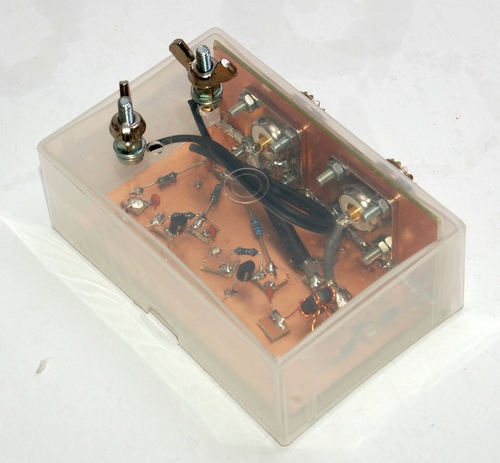
February 19, 2012 - UK Band plans on your mobile phone
I just finished a mobile app for UK band plan:
https://phil-wise.com/bandplan
It makes use of HTML5 application caching, so if you bookmark the page to the home screen on an IOS or android device, it will work even when you are offline.
Please try it out, any feedback is welcome.
February 4, 2012 - Small Wonder Labs SW+40
I just finshed putting my Small Wonder Labs SW+40 (pdf) in a case. I've built two kits from Dave Benson now, and both have been excellent. The stock SW+40 doesn't come with a keyer (unlike the Rockmite!) so I needed to put one together. I could have bought one of the many pre-programmed PIC keyers that are floating around, but I'm an open source kind of guy who doesn't like buying things I can't take apart and understand. Instead I spent many pleasurable hours writing one that is very easy to port to new devices, which I'll open source sometime.
One of the use cases for this rig is going to be SOTA activations, and I didn't want a separate battery kicking around, nor a power switch that could be easy knocked on. Since I was writing embedded software anyway, I made the rig auto power on when the paddle is pressed and power off after 20 minutes of no activity. It draws about 100nA on power off, so the embedded 800mAh LiPo should last a long time.
There was a contest on today, so I got the chance to compare it to my FT-857's receiver. Frankly the SW+40 is nicer. It has a sharper filter and doesn't suffer from AGC pumping like the '857. The transmitter is ~20db down but it does come with diode QSK :)
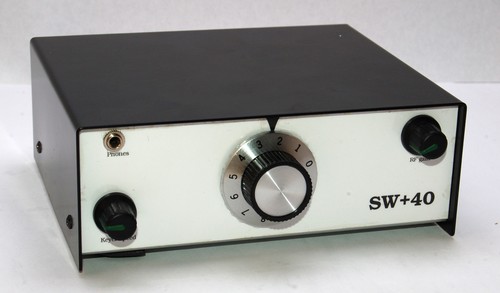
February 2, 2012 - Getting better at RufzXP
Am I getting any better at morse? Let's use my RufzXP score as a proxy and plot that over time (the x axis is days):
(graph lost when Posterous went 'startup')
I'm getting better slowly, apparently. The trend line says I manage about 8 more points per day, which is pretty crappy. I need to find a better way to get train.
September 15, 2011 - Poland on the Rockmite
Back in the dim and distant past as an undergrad I bought a Rockmite 20m kit radio from Small Wonder Labs. It is a crystal controlled, direct convertion rig with a built in keyer.
It only runs 500mw, and I sat and called CQ with it in the shack for a bit today. Just as I was about to give up I heard a SQ calling, he was loud and on one of the two frequencies that the rockmite can use. I called him back.
M 0 D E G, oh yes! He can hear me! We had a quick exchange of signal reports and names, which was confused a little at my end because the direct convertion architecture of the rockmite means that there is an image response approximately 1.4khz (twice the sidetone frequency) from the transmit frequency. I heard a loud station while I was transmitting (rockmite has diode QSK) and stopping to figure out what was happening wasn't the right move. It all worked out in the end, and the rockmite gets another one in the log.
There is something magical about making contacts on the rockmite that I don't get on the FT-1000 + Quadra that sits next to it. Part of it is that a kw amp, sharp crystal filters and no broadcast band break band break in makes contacts easy, but I think there is a more subtle thing at work: I understand the operation of the rockmite from top to bottom.
February 19, 2011 - Shielded magnetic loop vs Vertical: Trying Science
I've got S9 noise problems, and I wanted to build a shielded magnetic loop to try and reduce the near field noise sources. Rather than just build the thing and convince myself that it was better, I want to do something approaching a real experiment.
The hypothesis is that the loop will out perform the vertical. I built a quick shielded magnetic loop using 3m of RG58 and a FT37-42 balun. Because the impedence of a small loop is low, I made it with a 1:4 impedence ratio using 10 trifiliar windings and connecting two of them in series.
This was mounted with the center about 2m off the ground. I could hear signals on both the Vert and Loop. All good.
I then ran WSPR and switched between the two antennas every 16 minutes by hand. A quick python script on the ALL_WSPR.txt file gets the data into a form I can use. The next question is how to analyse the data, and it is important to do this because actually looking at the data.
The scheme I picked was to find all the call signs that were copied on both antennas, and plot a scatter graph of all the SNR for each pair of reception reports. If a call sign was heard twice on one antenna and three times on the other, there would be 6 points plotted.
This should result in a nice win/loose graph with the diagonal representing a dead heat.
I tried to fit a line though the resulting graph, and the good news is that the slope is about 1.0, which you would expect. The y-intercept is the critical value, and should give the relative performance number we want...

+0.4db, in favour of the vertical.
Well that is a surprise on two counts. I thought that the vertical would be worse, and this means that I don't have to carry on with plans to build a separate recieve antenna and antenna switching system. It is also very small, hinting that something that we are not measuring is causing the noise problems.
February 13, 2011 - Spark Gap Tx
(download)
As a little experiment I Wired a relay up to oscillate to see if it would work as a spark gap transmitter. Using a shortwave AM worldband receiver, it was audible down to the end of the road.
Might make a fun project for scouts?
January 29, 2011 - Noise
One of the advantages of owning a house is that you can drill holes in it with abandon. It's now time to get a shack going at home. When I was renting I had a bit of RG-58 going through a half open window that was sealed with duct tape, this time I borrowed a 400mm drill from Rob and smacked a hole through the wall of my office. The original plan for the antenna at the house was a vertical with an LDG auto tuner, but for now a quarter wave vertical for 40m will do.
I had a length of Westflex that was scavenged from the CUWS shack, together with a 10m SOTA pole and a few radials and I'd got something up. If it works out then it is worth investing some big digging in lots of radials and generally tidying the thing up.
Let's see what's on. S9 noise mostly. Dam. Dam. Dam. There's a French contest going on, but the only stations I can hear are outside France. I catch one bloke who gives a department report, but he fades into the noise.
I see what is going on on the other bands, not that I can transmit on them. Nothing on 30, but there is stuff on 80. Flick to 160, holy cow! I copy a whole bunch of folks calling, and a quick check reveals that the CQWW 160 contest is this weekend.
S9 noise sucks.
January 29, 2011 - Shack
Went down to the shack between work and the pub, the plan was to drop my 20m Rockmite off and start a club wide challenge to see what we can work on half a watt.
Unfortunately 20 was dead, I could only hear a couple of stations on the real radio, so it was unlikely to work. Called CQ for 10-15 minutes anyway, but no takers. Not a great start, but there is plenty more juice in the battery pack yet.
40 was a better bet, there was a guy running a big pileup faster than I can follow so I let that one go. Worked E77AW and bungled through a QSO. Got a name and Qth (almost) but I think he asked a question or something. Gave him my name and a report, but soon got lost. I feel pretty rubbish at my attempts, I'm not sure what the other side thinks of my poor skills, but in the end practice is the only way to get better. I hope that one day I'll be reminding myself of that from the other side of the table. I send him 73s and say thank you. He starts calling CQ after a few seconds.
I tune around and spot a pile up, tuning down I copy VY2NU, it isn't crazy fast and I'll only have to copy enough to check my call is correct. I love the chase of trying to figure out where the DX is working in the pile up,. Flick the linear on. That helps. I hear him come back to a call, which sounded similar to one I just heard, him sending 599 will be the proof. He does. DX sends TU and I hit the key.
M0... Oh yeh! First call too. I send my 5nn and the pile up drives on, only I'm in the log now.
In the pub chat turns to a plan to take Rob's IC2KL up a sota. Most of the weight is in the 40v linear PSU, so it seems plausible that 4 11v LiPo battery packs would do the job nicely.
March 2, 2010 - DX Cluster on your phone
Michael, G7VJR runs the rather handy DX Lite mobile phone optimised DX cluster, which is optimised for iPhone sized screens.
Unfortunately it doesn't layout well for those of us on smaller handsets which have a full web browser but are much more limited in screen width.
So I've written dx.phil-wise.com, which takes the XML data feed that Michael kindly provides and renders it in format for smaller devices. Hopefully this is useful to someone, any comments are welcome.
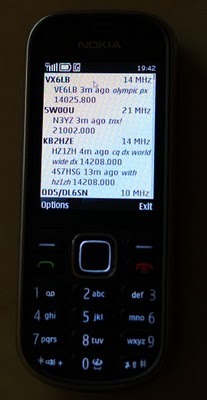
February 10, 2010 - Handy Dipole Winders
I knocked these up in 10 minutes last night using a piece of laminate flooring I picked up cheap and a jigsaw:
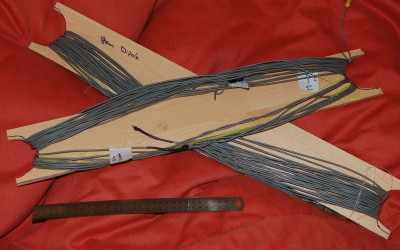
Dipole winder, 30cm ruler for scale
They are about 600mm long, you get 4 from a single sheet.
December 6, 2009 - Ideal contest log window layout
Is there a one true, perfect screen layout for contest logging?
WT and N1MM loggers are great in the sheer amount of options that are available, but every time I take over operating at a contest all the windows are in the 'wrong' place and the window I really need is hidden and I've got to dig through about a hundred options to display it.
Is it possible to come up with a window layout that is good enough for everyone? I think there might have to be several modes available, since the needs of a pilot station are pretty different to someone running at a couple of hundred Q's/hour.
Or am I wrong? The running station wants to know his rate, a SCP window and propagation information. Other than super check partial, all this is useful to the pilot station too.
In order to start answering this question it would be great to collect a set of screenshots of your desktop as you have it set up for contest operating. It would be a great help if you could open up your logging software and email a screenshot to p at beta16 dot co dot uk now, and I'll put together another post summarising what your send in.
Thanks!
November 10, 2009 - Shameless Gloat
If my wife can have a Radley handbag, I can have an expensive morse key. Behold! My new Bengali Magnetic Traveler Light.
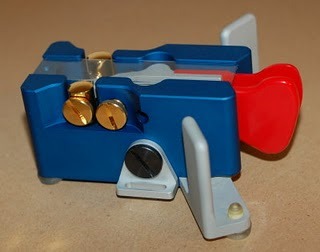
At over 200 euro it isn't cheap by any standards, but I wanted a key for three purposes:
- Shack usage
- SOTA expeditions
- DXpeditions (not that I have any hope of running a pileup today)
I've been borrowing the trusty CUWS Bencher for a while now, and while it is a fine key, it is far to fragile to travel with, let alone lug up a hill. One option would be to supliment it with a Palm Paddle for 'on the road' usage. The combination of Palm Paddle+Bencher is close to the Bengali key in terms of price, and neither is as nice to use to boot.
In the end it isn't cheap, but nice things are nice to have.
October 5, 2009 - Ham radio and the Internet
I was discussing the future of ham radio with Dom M0BLF in the pub last week, and I thought it would be interesting to put my thoughts down on paper. These opinions are a) loud, and b) my own.
Firstly, the era when ham radio was interesting because you could talk to people in far away places was over when long distance telephones (and more recently/cheaply the Internet) came along. Facebook and Skype provide a much better interface to talk to people with shared interests than calling CQ on 20m does. I'm not saying 'get off the bands', I'm saying that this aspect of radio has no long term future.
There are two aspects of the hobby that still provide an interesting challenge. One is self-training and the other is radio sport/contesting.
I'm not much of a homebrewer myself, but I can see the appeal. The Internet and powerful computers offer the opportunity to build increasingly more interesting things, discuss them with other people and find someone else to talk to with your new crazy data mode. There are definitely 'Web-2.0' opportunities here. It would be handy to be able to say 'anyone around who wants to do some tests of my new modulation scheme?' and quickly find someone. This happens today on mailing lists, but a website could provide a better experience.
The second interesting thing is contesting. This is not self-education. It is sport, and should be considered along the same grounds. There has always been the issue of how much (computer) assistance is allowed, but this is a problem that is shared with all sports. I think the UCI, who govern road cycling have the right line on this. The concept is 'Primacy of man over machine', which means that you or I can go and buy a bike that would win the Tour De France for less than 10 grand. Now think how far 10 grand would get you in motorsport.
Contesting is only meaningful if it involves significant operator skill, which basically means SSB and CW. Digital voice is possibly better than SSB, and PSK31 is easily better for communication than CW, but that doesn't matter. We pick the rules to make the contest interesting.
Computers making QSOs over the Internet is not interesting, but there are plenty of interesting things that could be done given that most machines are Internet connected. A real-time leader board would be an interesting thing to try.
More detail of the operation of individual stations would be useful to stop cheaters using forms of assistance that are against the rules. For example, a history of the VFO frequencies would easily identify users of packet spotting networks. There are parallels with Bridge here. In Bridge the bidding process is the only way the two partners can reveal what cards they hold, and there are strict rules against revealing information any other way, by scratching your nose, or in the timing of the bids for example. When someone is accused of cheating at the high levels of the game, the hand history is shown to a panel of expert judges who assess if the play could be adequately explained by the bidding that took place. Recording the entire contents of the HF bands and the entire history of everyone's VFO throughout a HF contest is well within the capabilities of modern technology.
I haven't talked about chasing DX or emergency communications. That is because I don't really understand them. Don't get me wrong, cracking a pile-up is great fun and running a pile-up is great fun.
In terms of things that we can do now, here is my list:
- Encourage experimentation by removing all bandwidth restrictions from most of the VHF and up spectrum. Save a 50kHz chunk at the end of the bands for DX communication, but we don't need restrictions on bands that currently underused. 70cms, I'm looking at you.
- Someone build a Softrock for VHF & up.
- Remove any remaining 'unattended operation' and ident restrictions. As long as you don't transmit out-of-band, crack on.
- Build a Internet forum for people to other willing people to do tests with. Might be 'someone with a USRP and gnuradio near Cambridge' or 'someone to practice 12wpm morse with'
- Everyone enter contests (or categories) that favour skill over equipment. I like the 'sprint' format, with the crazy QSY rule.